
Drosera, commonly known as the sundews, is one of the largest genera of carnivorous plants, with at least 194 species. These members of the family Droseraceae lure, capture, and digest insects using stalked mucilaginous glands covering their leaf surfaces. The insects are used to supplement the poor mineral nutrition of the soil in which the plants grow. Various species, which vary greatly in size and form, are native to every continent except Antarctica.
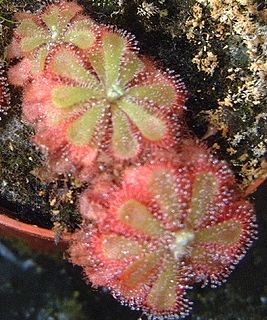
Drosera aliciae, the Alice sundew, is a carnivorous plant in the family Droseraceae. It is native to the Cape Provinces of South Africa, like Drosera capensis, the cape sundew, and is one of the most common sundews in cultivation. The plant forms small, tight rosettes of wedge-shaped leaves, up to 5 cm in diameter. Under conditions of good lighting, the insect-snagging tentacles will become deeply coloured with anthocyanin pigments, which probably aid in its attraction of insect prey. The plant is relatively easy to grow, and produces attractive scapes of pink flowers, which are held about 30 cm away from the carnivorous leaves, so as to prevent pollinators from becoming ensnared. D. aliciae is very similar in form to a number of other closely related species such as D. slackii, and D. dielsiana: the former is rather larger ; the latter rather smaller.
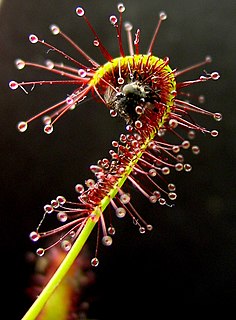
Drosera capensis, commonly known as the Cape sundew, is a small rosette-forming carnivorous species of perennial sundew native to the Cape in South Africa. Because of its size, easy to grow nature, and the copious amounts of seed it produces, it has become one of the most common sundews in cultivation, and thus, one of the most frequently introduced and naturalised invasive Drosera species.

Drosera regia, commonly known as the king sundew, is a carnivorous plant in the sundew genus Drosera that is endemic to a single valley in South Africa. The genus name Drosera comes from the Greek word droseros, meaning "dew-covered". The specific epithet regia is derived from the Latin for "royal", a reference to the "striking appearance" of the species. Individual leaves can reach 70 cm (28 in) in length. It has many unusual relict characteristics not found in most other Drosera species, including woody rhizomes, operculate pollen, and the lack of circinate vernation in scape growth. All of these factors, combined with molecular data from phylogenetic analysis, contribute to the evidence that D. regia possesses some of the most ancient characteristics within the genus. Some of these are shared with the related Venus flytrap (Dionaea muscipula), which suggests a close evolutionary relationship.

Drosera peltata, commonly called the shield sundew or pale sundew, is a climbing or scrambling perennial tuberous species in the carnivorous plant genus Drosera. Among the tuberous sundews, D. peltata has the largest distribution, which includes eastern and western Australia, New Zealand, India, and most of Southeast Asia including the Philippines. The specific epithet is Latin for "shield shaped", a reference to the shape of the cauline leaves. It is either a single extremely variable species, or a complex of several closely related species of uncertain taxonomic boundaries. In Australia at least four forms have had or still have specific taxonomic recognition: Drosera peltata subsp. peltata, D. peltata subsp. auriculata, D. foliosa and D. gracilis.

Drosera adelae, commonly known as the lance-leaved sundew, is a carnivorous plant in the genus Drosera that is endemic to Queensland, Australia.

Drosera madagascariensis is a carnivorous plant of the sundew genus (Drosera). It was described in 1824 by A. P. de Candolle and is native to Africa.

Drosera binata, commonly known as the forked sundew or fork-leaved sundew, is a large, perennial sundew native to Australia and New Zealand. The specific epithet is Latin for "having pairs" - a reference to the leaves, which are dichotomously divided or forked.
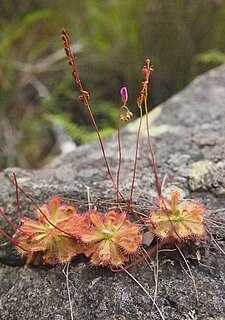
Drosera burmannii, the tropical sundew, is a small, compact species in the carnivorous plant genus Drosera. Its natural geographical range includes the tropical and subtropical regions of Asia, Australia, India, Japan,southeast Asia,Oceania, Africa and China 's Guangxi, Guangdong, Yunnan, Fujian, Taiwan. It normally spans only 2 cm (0.8 in) in diameter. It is one of the fastest trapping sundews as well, and its leaves can curl around an insect in only a few seconds, compared to the minutes or hours it takes other sundews to surround their prey. In nature, D. burmannii is an annual, but in cultivation, when grown indoors during the cold months, it can live for many years. Since D. burmannii is an annual, it produces large amounts of seed. Drosera burrmannii has been considered a powerful rubefacient in Ayurveda.

Drosera indica is an insectivorous plant, a sundew native to tropical countries throughout the world, from Asia to Africa, but absent from the neotropics. Together with Australian endemic species D. aquatica, D. aurantiaca, D. barrettorum, D. cucullata, D. finlaysoniana, D. fragrans, D. glabriscapa, D. hartmeyerorum, D. nana, D. serpens it makes up the section Arachnopus.
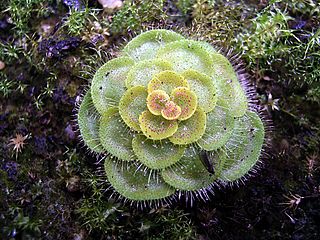
Drosera zonaria, the painted sundew, is a perennial tuberous species in the carnivorous plant genus Drosera and is endemic to south-west Western Australia from near Perth southeast to near Esperance. It grows in a tight rosette approximately 5 to 7 cm in diameter with 20 to 30 green to red leaves that are arranged in concentric layers. The leaves are typically 1 cm wide and are usually described as being "kidney-shaped" with crimson leaf margins. It grows in deep silica sands in open woodland or coastal heathland and only flowers after a bush fire, which is speculated to be caused by the release of ethylene. Its white, sweetly perfumed flowers, which are very similar to those of D. erythrorhiza, emerge on 4 to 5 cm tall scapes. As with most other tuberous Drosera species, D. zonaria will die back during the dry summer months and retreat to the fleshy tuber 10 to 30 cm below ground.

Drosera gigantea, the giant sundew, is an erect perennial tuberous species in the carnivorous plant genus Drosera that is endemic to Western Australia. It grows in sandy soils at the margins of swamps and near granite outcrops along the Western Australian coast from Albany north to just south of Geraldton. D. gigantea produces small shield-shaped leaves along many lateral branches that look like a small tree. Individual plants can grow up to 0.2–1 m (0.7–3.3 ft) tall. Because of its tall, tree-like form, it is considered one of the largest Drosera species. It is also easily cultivated and enjoys damp, humid conditions often provided in greenhouses. White flowers emerge from August to November. The red tubers of this species can grow to be 3.8 cm (1.5 in) in diameter and may be a metre below ground.

Drosera glanduligera, the pimpernel sundew, is a rosetted annual species in the carnivorous plant genus Drosera that is endemic to Australia. It is 2.5–6 cm (1–2 in) tall and grows in most soil conditions. It produces orange flowers from August to November. It was originally described in 1844 by Johann Georg Christian Lehmann. It is the sole species in the subgenus Coelophylla, which Jan Schlauer elevated from section rank in 1996; it was originally described by Jules Émile Planchon in 1848.

Drosera darwinensis is a perennial carnivorous plant in the genus Drosera that is endemic to the Northern Territory. Its leaves are arranged in a rosette with one rosette emerging from the root stock. It produces pink or white flowers from December to April. Drosera darwinensis grows in clayey sand from Palmerston to Berry Springs south of Darwin and east to Humpty Doo. It was first described by Allen Lowrie in 1996; the type specimen was collected 0.9 km (0.6 mi) south of Temple Avenue in Palmerston on 8 April 1990. The specific epithet darwinensis refers to region where this plant is found in abundance. It is closely related to D. brevicornis, but differs from that species by its shorter inflorescence.

Drosera derbyensis is a perennial carnivorous plant in the genus Drosera and is endemic to Western Australia. Its erect or semi-erect leaves are arranged in a rosette with one or more rosettes emerging from the root stock. The petioles are narrowly oblanceolate, 0.8–1.0 mm wide at the proximate end and 1.3–1.7 mm wide at the apex, narrowing to 0.5–0.7 mm at the laminar base. The petioles are frequently 35–45 mm long when the plant is in flower and are covered in white woolly non-dendritic hairs. The insect-trapping leaf lamina is orbicular and much shorter than the petioles at only 2–3 mm in diameter. The laminar adaxial surface is covered in insect-trapping glands. Each rosette produces 1–4 raceme inflorescences, which are 25–35 cm (10–14 in) long. Each inflorescence bears 30–50 white flowers, with flowering occurring from March to June. The upper portion of the scape and the abaxial surface of the sepals are covered with white woolly non-dendritic hairs. Its roots are fibrous. Drosera derbyensis grows in sandy soils in floodways or near rock outcrops from Derby to Beverley Springs in the Kimberley region.
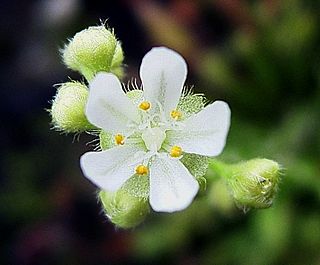
Drosera dilatato-petiolaris is a carnivorous plant in the genus Drosera and is endemic to Australia, being found in both Western Australia and the Northern Territory. Its leaves are arranged in a rosette and commonly produces plantlets, eventually forming large clumps that can be over 1 ft (0.3 m) across. Green petioles emerging from the center of the rosette are typically 3–5 mm wide, but can vary. Red carnivorous leaves at the end of the petioles are small and round, with most resting on the soil surface. Inflorescences are 18 cm (7 in) long with white flowers being produced from April to May. It has a diploid chromosome number of 2n = 12.
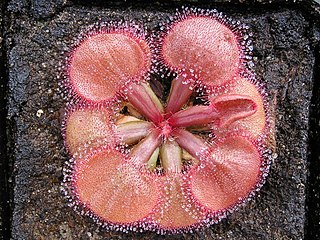
Drosera falconeri is a carnivorous plant in the genus Drosera. It is endemic to the Northern Territory of Australia.

Drosera kenneallyi is a carnivorous plant in the genus Drosera and is endemic to the Kimberley region in northern Western Australia. Its leaves are arranged in a compact basal rosette appressed to the soil. Narrowly oblanceolate petioles emerging from the center of the rosette are typically 1.5–2.2 mm wide at their widest. Red carnivorous leaves at the end of the petioles are small at 2–3 mm in diameter and elliptic to broadly ovate. Inflorescences are 12.5–20.5 cm (5–8 in) long with white flowers being produced on 10- to 20-flowered racemes from November to December.
Drosera viridis is a semi-erect or rosetted perennial species in the carnivorous plant genus Drosera. It is known only from Brazil, being found in eastern Paraná and São Paulo and central Santa Catarina at elevations from 550–1,100 m (1,800–3,610 ft). It may, however, also be found in adjacent Argentina, Paraguay, and Uruguay. It typically grows in waterlogged habitats among grasses in white-clayey, reddish lateritic, or humus-rich black-brown soils and is sometimes found submerged with only the leaves above water.

Drosera admirabilis, commonly referred to as the "floating sundew", is in the carnivorous us plant family Droseraceae. The nickname "admirabilis" was first used in literature by Paul Debbert in 1987 and was derived from how "admirable" the plant appears when it reaches a fully matured specimen. Structurally similar to Drosera aliciae, and Drosera cuneifolia, the D. admirabilis grows in a single tight rosette-shaped leaf bundle. The leaves widen towards the end and have rounded tips. Leaves lay horizontally under proper lighting conditions. Like many other African sundews, D. admirabilis is a perennial. D. admirabilis has outer tentacles like those of Drosera glanduligera, Drosera sessilifolia and Drosera burmannii which briefly after stimulation bend towards the prey.




















